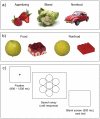Food catches the eye but not for everyone: a BMI-contingent attentional bias in rapid detection of nutriments
- PMID: 21603657
- PMCID: PMC3095600
- DOI: 10.1371/journal.pone.0019215
Food catches the eye but not for everyone: a BMI-contingent attentional bias in rapid detection of nutriments
Abstract
An organism's survival depends crucially on its ability to detect and acquire nutriment. Attention circuits interact with cognitive and motivational systems to facilitate detection of salient sensory events in the environment. Here we show that the human attentional system is tuned to detect food targets among nonfood items. In two visual search experiments participants searched for discrepant food targets embedded in an array of nonfood distracters or vice versa. Detection times were faster when targets were food rather than nonfood items, and the detection advantage for food items showed a significant negative correlation with Body Mass Index (BMI). Also, eye tracking during searching within arrays of visually homogenous food and nonfood targets demonstrated that the BMI-contingent attentional bias was due to rapid capturing of the eyes by food items in individuals with low BMI. However, BMI was not associated with decision times after the discrepant food item was fixated. The results suggest that visual attention is biased towards foods, and that individual differences in energy consumption--as indexed by BMI--are associated with differential attentional effects related to foods. We speculate that such differences may constitute an important risk factor for gaining weight.
Conflict of interest statement
Figures



Similar articles
-
Measuring attentional bias to food cues in young children using a visual search task: An eye-tracking study.Appetite. 2020 May 1;148:104610. doi: 10.1016/j.appet.2020.104610. Epub 2020 Jan 17. Appetite. 2020. PMID: 31958480 Free PMC article. Clinical Trial.
-
Cognitive Food Processing in Binge-Eating Disorder: An Eye-Tracking Study.Nutrients. 2017 Aug 19;9(8):903. doi: 10.3390/nu9080903. Nutrients. 2017. PMID: 28825607 Free PMC article.
-
Effects of laparoscopic sleeve gastrectomy on attentional processing of food-related information: evidence from eye-tracking.Surg Obes Relat Dis. 2014 Mar-Apr;10(2):277-82. doi: 10.1016/j.soard.2013.09.012. Epub 2013 Sep 23. Surg Obes Relat Dis. 2014. PMID: 24355326
-
The neural substrates of subliminal attentional bias and reduced inhibition in individuals with a higher BMI: A VBM and resting state connectivity study.Neuroimage. 2021 Apr 1;229:117725. doi: 10.1016/j.neuroimage.2021.117725. Epub 2021 Jan 20. Neuroimage. 2021. PMID: 33484850
-
Attentional bias to food-related visual cues: is there a role in obesity?Proc Nutr Soc. 2015 Feb;74(1):37-45. doi: 10.1017/S002966511400144X. Epub 2014 Sep 19. Proc Nutr Soc. 2015. PMID: 25236786 Review.
Cited by
-
Visual food cue processing in children with Prader-Willi Syndrome.Physiol Behav. 2021 Sep 1;238:113492. doi: 10.1016/j.physbeh.2021.113492. Epub 2021 Jun 8. Physiol Behav. 2021. PMID: 34116052 Free PMC article.
-
Fat Content Modulates Rapid Detection of Food: A Visual Search Study Using Fast Food and Japanese Diet.Front Psychol. 2017 Jun 22;8:1033. doi: 10.3389/fpsyg.2017.01033. eCollection 2017. Front Psychol. 2017. PMID: 28690568 Free PMC article.
-
An Open Trial Targeting Food Cue Reactivity and Satiety Sensitivity in Overweight and Obese Binge Eaters.Cogn Behav Pract. 2017 Aug;24(3):363-373. doi: 10.1016/j.cbpra.2016.08.003. Epub 2016 Oct 5. Cogn Behav Pract. 2017. PMID: 29269997 Free PMC article.
-
Food Captures Attention, but Not the Eyes: An Eye-Tracking Study on Mindset and BMI's Impact on Attentional Capture by High-Caloric Visual Food Stimuli.J Cogn. 2022 Feb 21;5(1):19. doi: 10.5334/joc.210. eCollection 2022. J Cogn. 2022. PMID: 36072118 Free PMC article.
-
Color's Indispensable Role in the Rapid Detection of Food.Front Psychol. 2021 Nov 24;12:753654. doi: 10.3389/fpsyg.2021.753654. eCollection 2021. Front Psychol. 2021. PMID: 34899494 Free PMC article.
References
-
- Corbetta M, Shulman GL. Control of goal-directed and stimulus-driven attention in the brain. Nature Reviews Neuroscience. 2002;3:201–215. - PubMed
-
- Itti L, Koch C. Computational modelling of visual attention. Nature Reviews Neuroscience. 2001;2:194–203. - PubMed
-
- Vuilleumier P. How brains beware: neural mechanisms of emotional attention. Trends in Cognitive Sciences. 2005;9:585–594. - PubMed
-
- Lang PJ, Bradley MM, Cuthbert BN. Emotion, Attention, and the Startle Reflex. Psychological Review. 1990;97:377–395. - PubMed
Publication types
MeSH terms
LinkOut - more resources
Full Text Sources

